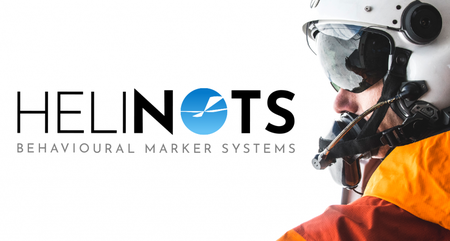A new system designed to recognise the non-technical skills required by the helicopter pilots flying search and rescue missions and those who fly workers to offshore installations, has been developed by the University of Aberdeen.
The HeliNOTS system outlines the non-technical skills (NTS) recognised as vital to the role of these specialised pilots.
Non-technical skills (NTS) are the social and cognitive skills that, alongside technical know-how, ensure safe and effective work performance. The aviation industry recognised the importance of these skills decades ago, following a series of fatal incidents.
In 1972 Flight 401 crashed into the Everglades after the crew became so focused on a malfunctioning landing light that they failed to notice the autopilot had disengaged. This was a case of lapse in situation awareness caused by attentional narrowing when attention becomes so focused on one task other environmental cues are missed.
The message of the importance of these skills has since spread to other industries ranging from nuclear power to healthcare. High-risk industry has invested in extensive research to understand these skills in different contexts and generated tailored tools to support learning.
Over the last three years Oliver Hamlet of the Applied Psychology and Human Factors Group (APHF) at The University has worked in collaboration with Bristow Helicopters Ltd in Aberdeen to bring the focus of NTS research back to aviation by examining NTS in helicopter search and rescue and offshore transport missions.
Having worked with hundreds of helicopter pilots and crew members, Oliver and the APHF team have now unveiled tailor-made NTS handbooks for both groups – known as HeliNOTS systems.
Oliver Hamlet said: “The HeliNOTS systems are the result of research we have conducted exploring the social and cognitive skills of offshore transport and search and rescue helicopter pilots. As our research progressed, we recognised a need for tailor-made, mission specific tools to be designed for the industry.
“We developed two HeliNOTS systems – O for offshore transport pilots, and S for search and rescue pilots – to better outline the context-specific key behaviours and skills utilised across these two flight mission types.”
Both systems were constructed in consultation with pilots, training providers and industry experts. One major UK helicopter operator is already looking to incorporate HeliNOTS into pilot training regimes.
Oliver Hamlet added: “While research has looked at the skillsets of fixed-wing commercial aviation pilots, until now no work has been conducted to explore the non-technical skills of search and rescue and offshore transport teams as part of a broad non-technical skills framework nor compared the skill utilisation, and emphases of these pilot groups.
“The role of a search and rescue pilot is very different to the role of an offshore transport pilot. While both use these skillsets, the context and associated behaviours can be quite different. For example, both pilot groups engage in planning and flight preparation but while offshore pilots might focus on the flight schedule and weather conditions, search and rescue pilots need to consider, and prepare for the severity of potential injuries to casualty being rescued and the difficulties inherent in reaching them.
“This understanding of how different mission parameters impact NTS, was an important step towards understanding these behaviours and tailoring our approach. HeliNOTS takes context into account producing behavioural markers of NTS that are tailored to mission type.”
In addition, HeliNOTS (S) also introduces cognitive readiness, an original NTS category, specific to the search and rescue environment.
“The cognitive readiness category highlights a range of resilience, problem-solving and preparedness behaviours,” explains Oliver Hamlet.
“These aspects were emphasised as important within dynamic rescue environments, operating under high pressure, and managing casualties. The category seeks to encapsulate these elements under a distinct heading to facilitate these aspects in practice”.
Oliver’s development of HeliNOTS recently gained recognition for its industrial impact by the University of Aberdeen and the Scottish Graduate School of Social Sciences.
Information regarding the HeliNOTS systems can be accessed via the university website: https://research.abdn.ac.uk/applied-psych-hf/helinots/
Oliver will be presenting a live webinar at on the 24th of August (12:00 – 13:00), discussing the development and expected usage of the HeliNOTS systems. Free registration is available from: https://www.eventbrite.co.uk/e/helinots-webinar-tickets-117241998975


